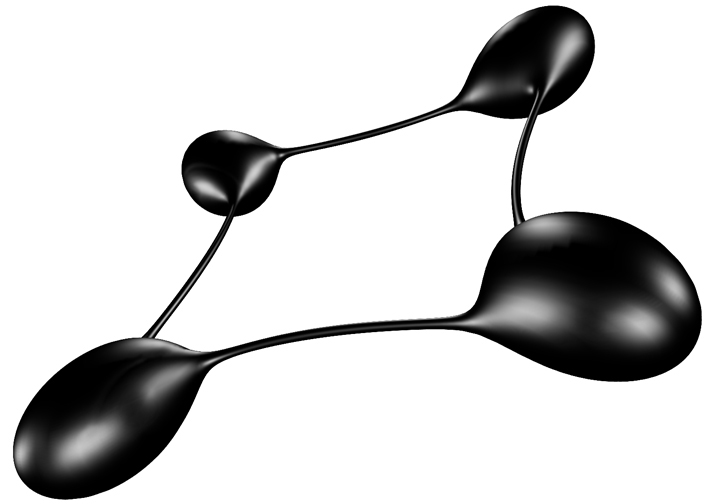Numerical relativity reveals possible violation of cosmic censorship in higher dimensions
Numerical simulations of Einstein’s equations of general relativity provided the first concrete evidence that the weak cosmic censorship conjecture can be violated in five-dimensional asymptotically flat spacetimes, where the simulations show that singularities can generically form without being hidden behind a black hole horizon. Asymptotically flat spacetimes are considered most relevant in practical applications.
PhD students Markus Kunesch and Saran Tunyasuvunakool from the CTC, led by Pau Figueras from Queen Mary University of London, have successfully simulated the nonlinear dynamics of `black rings’ in five dimensions. These black holes, which are shaped like very thin rings, are subject to the so-called Gregory-Laflamme instability that gives rise to a series of ‘bulges’ connected by strings that become thinner over time. These strings eventually become so thin that they pinch off into a series of miniature black holes, similar to how a thin stream of water from a tap breaks up into droplets.

Black rings were identified as an exact solution to Einstein’s equations in five dimensions by Roberto Emparan and Harvey Reall in 2002. The solution is known to be linearly unstable under small perturbations, but this is the first time that their nonlinear dynamics have been successfully simulated using supercomputers. The evolution points towards the appearance of a ‘naked singularity’, which would cause the equations behind general relativity to break down outside of a black hole. The results are published in the journal Physical Review Letters.
General relativity underpins our current understanding of gravity: everything from the estimation of the age of the stars in the universe, to the GPS signals we rely on to help us navigate, is based on Einstein’s equations. In part, the theory tells us that matter warps its surrounding spacetime, and what we call gravity is the effect of that warp. In the 100 years since it was published, general relativity has passed every test that has been thrown at it, but one of its limitations is the existence of singularities, where Einstein’s equations break down mathematically.
Exact stationary black hole solutions generally contain a singularity at the centre, hidden behind an event horizon. Current theoretical expectation is that any singularity which forms as a result of dynamical physical processes must also be surrounded by a black hole horizon. This allows observers outside of black holes to use Einstein’s equations to predict spacetime behaviour indefinitely far into the future.
“As long as singularities stay hidden behind an event horizon, they do not cause trouble and general relativity holds - the ‘cosmic censorship conjecture’ says that this is always the case,” said study co-author Markus Kunesch, a PhD student at the CTC. “As long as the cosmic censorship conjecture is valid, we can safely predict the future outside of black holes. Because ultimately, what we’re trying to do in physics is to predict the future given knowledge about the state of the universe now.”
A singularity which exists outside of a black hole horizon is called a ‘naked singularity’. Without the horizon, information from a naked singularity can reach an arbitrary distance in space. The failure of Einstein’s equations at the singularity would therefore cascade into a failure to predict the future of the spacetime.
“If naked singularities exist, general relativity breaks down,” said co-author Saran Tunyasuvunakool, also a PhD student at the CTC. “It would no longer have any predictive power – it could no longer be considered as a standalone theory to explain the universe.”
The cosmic censorship conjecture was first formulated informally by Roger Penrose in 1969, and over the years the statement of the conjecture has been made mathematically precise. However, the result remains unproven. One way to gain an insight is to study general relativity in higher dimensions and see if cosmic censorship still holds there. Failure of the conjecture in higher dimensions could help identify properties specific to four-dimensional spacetimes which makes it particularly suitable for general relativity. The discovery of black rings in five dimensions led scientists to hypothesise that they could break up and give rise to a naked singularity.

The COSMOS supercomputer.
(Photograph by Phil Mynott, www.philmynottphoto.co.uk)
Using the COSMOS supercomputer, the researchers were able to perform a full simulation of Einstein’s complete theory in five dimensions, allowing them to not only confirm that these ‘black rings’ are unstable, but to also identify their eventual fate. Most of the time, a black ring collapses back into a sphere, so that the singularity would stay contained within the event horizon. Only a very thin black ring becomes sufficiently unstable as to form bulges connected by thinner and thinner strings, eventually breaking off and forming a naked singularity. The resulting extreme geometry was one of the motivations for the development of the GRChombo adaptive mesh refinement numerical relativity code, along with theoretical improvements to existing gauge conditions
“The better we get at simulating Einstein’s theory of gravity in higher dimensions, the easier it will be for us to help with advancing new computational techniques – we’re pushing the limits of what you can do on a computer when it comes to Einstein’s theory,” said Tunyasuvunakool. “If cosmic censorship doesn’t hold in higher dimensions, then maybe we need to look at what’s so special about a four-dimensional universe that means it does hold.”
The COSMOS supercomputer at DAMTP is part of the Science and Technology Facilities Council (STFC) DiRAC HPC Facility.
Adapted from an article originally published by the University of Cambridge, licensed under a Creative Commons Attribution 4.0 International License.
Reference:
Pau Figueras, Markus Kunesch, and Saran Tunyasuvunakool ‘End Point of Black Ring Instabilities and the Weak Cosmic Censorship Conjecture.’ Physical Review Letters (2016). DOI: 10.1103/PhysRevLett.116.071102
Below are some films of the simulations.

